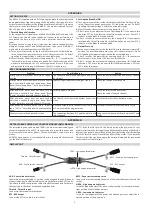
SERVICE MANUAL & ICA
WIPLINE 3730 & 3900 FLOATS
Page 24
Revision K
P/N 1002551
The main landing gear retractor is merely a hydraulic cylinder which pushes and pulls a drag brace. The locking
is accomplished using a small amount of lost motion of the hydraulic cylinder to pivot a hook on the drag brace.
The first part of travel of the cylinder unlocks the lock and the last part locks it. There is a proximity switch that
activates the gear panel indicator lights.
The main truss is an aluminum alloy and is connected to the drag brace through an air-oil oleo strut. The
main wheels and brakes and standard Cleveland parts. Aluminum brakes are used for saltwater resistance.
Interchangeable stainless steel brake discs are also available.
5.1 OPERATION
Reference Figure 5-1. A periodic cleaning and lubrication schedule is the best service there is for smooth and
trouble free operation. Lubrication is also a must for saltwater operation or where steel hardware and aluminum
come in contact with each other.
A lubrication chart is provided to show places of grease access and type of zerk to use. Use only waterproof
grease recommended in Products Chart.
At brake installation, apply STA-Lube synthetic brake and caliper grease or equivalent to brake caliper pins.
On Lubrication Chart, note 1 is a standard grease zerk. One is located on lower hook where actuating cylinder
is attached, and one on end of each wheel axle. The grease zerks on axle ends allow grease to be forced into
wheels. Use these to periodically add grease as it is lost and not as an alternate for repacking wheel bearings. If,
on some older models, lower hook does not have grease zerk, apply grease to all mating and hinged areas and
also to end of hook. Note 2 is a needle point grease hole where grease may be forced in with a needle point zerk
end. Note 3 is where grease is applied by hand to lubricate other moving or hinged surfaces. These areas should
include gear-up hook tip, push-rod to up-hook, down-lock hook tip, uplock hook push-rod, and any other moving
surface not mentioned above.
Greasing intervals matched to the usage of aircraft will provide a long service life. Even in minimal usage it is
recommended that the unit be cleaned and greased once at start of season, mid-season and end of season.
5.2 LUBRICATION
















































